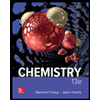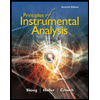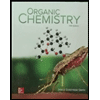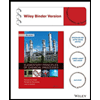
Interpretation:
The difference between intensive and extensive properties is to be determined.
Concept introduction:
The physical properties of the system are classified as follows:
1. Intensive properties: These depend on the nature of the substance.
2. Extensive properties: These depend on the amount of substance.
(a)
Interpretation:
Whether mass is an intensive or extensive property is to be determined.
Concept introduction:
The intensive properties are the properties that depend on the nature of the substance. It is independent of the size of the system. It remains the same if the system is further divided into a number of subsystems. Temperature, refractive index, and density are some of the examples of intensive properties.
The extensive properties are the properties that depend on the amount of substance. It is additive if the system is divided into a number of subsystems. Mass, color, energy, and volume are some examples of extensive properties.
(b)
Interpretation:
Whether density is an intensive or extensive property is to be determined.
Concept introduction:
The intensive properties are the properties that depend on the nature of the substance. It is independent of the size of the system. It remains the same if the system is further divided into a number of subsystems. Temperature, refractive index, and density are some of the examples of intensive properties.
The extensive properties are the properties that depend on the amount of substance. It is additive if the system is divided into a number of subsystems. Mass, color, energy, and volume are some examples of extensive properties.
(c)
Interpretation:
Whether the volume is an intensive or extensive property is to be determined.
Concept introduction:
The intensive properties are the properties that depend on the nature of the substance. It is independent of the size of the system. It remains the same if the system is further divided into a number of subsystems. Temperature, refractive index, and density are some of the examples of intensive properties.
The extensive properties are the properties that depend on the amount of substance. It is additive if the system is divided into a number of subsystems. Mass, color, energy, and volume are some examples of extensive properties.
(d)
Interpretation:
Whether the melting point is an intensive or extensive property is to be determined.
Concept introduction:
The intensive properties are the properties that depend on the nature of the substance. It is independent of the size of the system. It remains the same if the system is further divided into a number of subsystems. Temperature, refractive index, and density are some of the examples of intensive properties.
The extensive properties are the properties that depend on the amount of substance. It is additive if the system is divided into a number of subsystems. Mass, color, energy, and volume are some examples of extensive properties.
Want to see the full answer?
Check out a sample textbook solution
Chapter 1 Solutions
CHEM 212:CHEMISTSRY V 2
- Write the structure of the tripeptide Tyr-Val-Thr, indicate the N-terminal and C-terminal amino acids and point out the peptide bonds.arrow_forwardDraw the two anomers of D-Glucopyranose in Fisher projection and Haworth projection.arrow_forwardOrder the compounds from most to least reactive to electrophilic aromatic substitution and indicate the positions toward which the substituent is oriented: nitrobenzene, toluene, benzene, and bromobenzene. Explain your answer in terms of the inductive and resonance electronic effects of each substituent.arrow_forward
 ChemistryChemistryISBN:9781305957404Author:Steven S. Zumdahl, Susan A. Zumdahl, Donald J. DeCostePublisher:Cengage Learning
ChemistryChemistryISBN:9781305957404Author:Steven S. Zumdahl, Susan A. Zumdahl, Donald J. DeCostePublisher:Cengage Learning ChemistryChemistryISBN:9781259911156Author:Raymond Chang Dr., Jason Overby ProfessorPublisher:McGraw-Hill Education
ChemistryChemistryISBN:9781259911156Author:Raymond Chang Dr., Jason Overby ProfessorPublisher:McGraw-Hill Education Principles of Instrumental AnalysisChemistryISBN:9781305577213Author:Douglas A. Skoog, F. James Holler, Stanley R. CrouchPublisher:Cengage Learning
Principles of Instrumental AnalysisChemistryISBN:9781305577213Author:Douglas A. Skoog, F. James Holler, Stanley R. CrouchPublisher:Cengage Learning Organic ChemistryChemistryISBN:9780078021558Author:Janice Gorzynski Smith Dr.Publisher:McGraw-Hill Education
Organic ChemistryChemistryISBN:9780078021558Author:Janice Gorzynski Smith Dr.Publisher:McGraw-Hill Education Chemistry: Principles and ReactionsChemistryISBN:9781305079373Author:William L. Masterton, Cecile N. HurleyPublisher:Cengage Learning
Chemistry: Principles and ReactionsChemistryISBN:9781305079373Author:William L. Masterton, Cecile N. HurleyPublisher:Cengage Learning Elementary Principles of Chemical Processes, Bind...ChemistryISBN:9781118431221Author:Richard M. Felder, Ronald W. Rousseau, Lisa G. BullardPublisher:WILEY
Elementary Principles of Chemical Processes, Bind...ChemistryISBN:9781118431221Author:Richard M. Felder, Ronald W. Rousseau, Lisa G. BullardPublisher:WILEY





